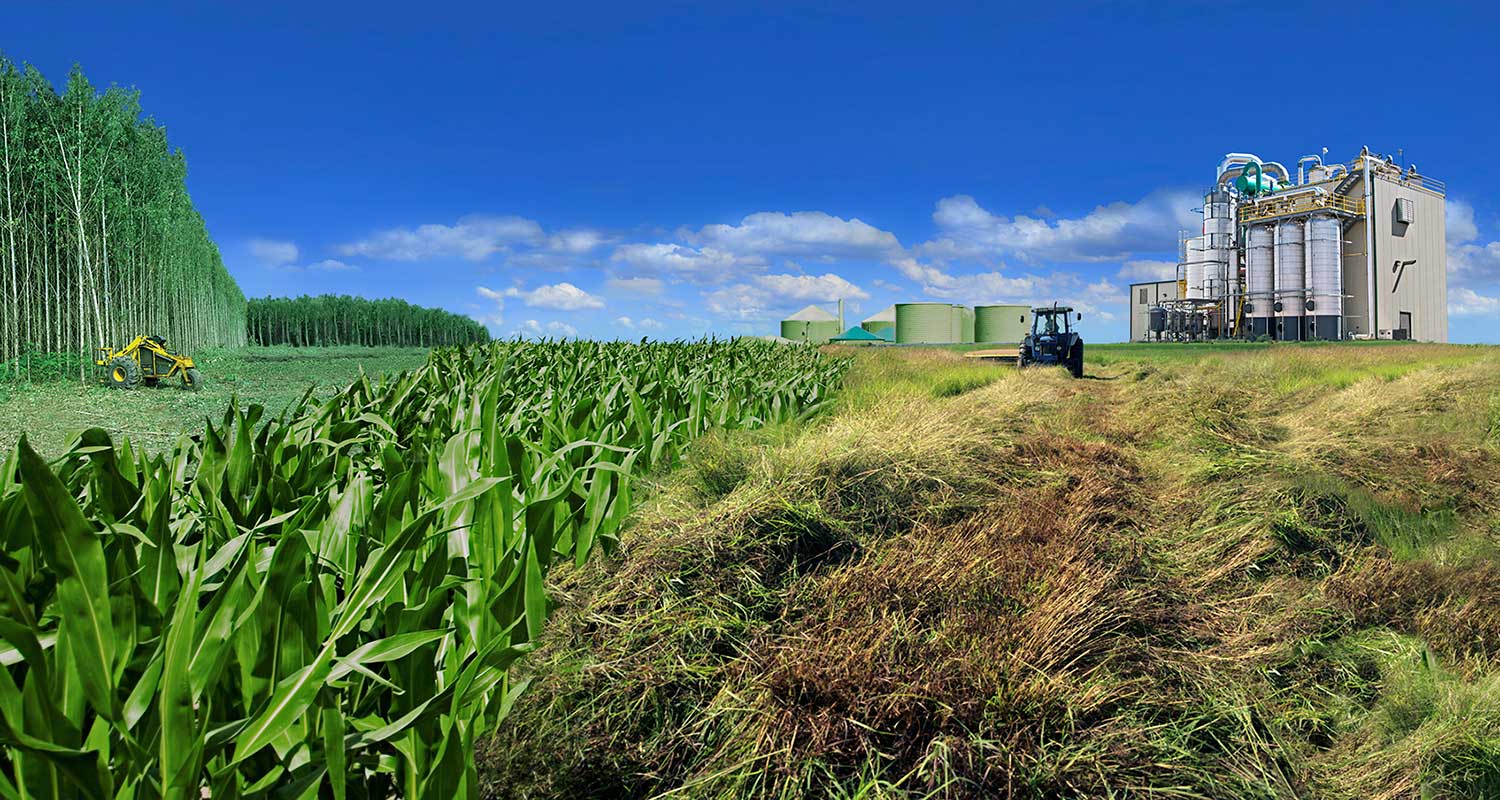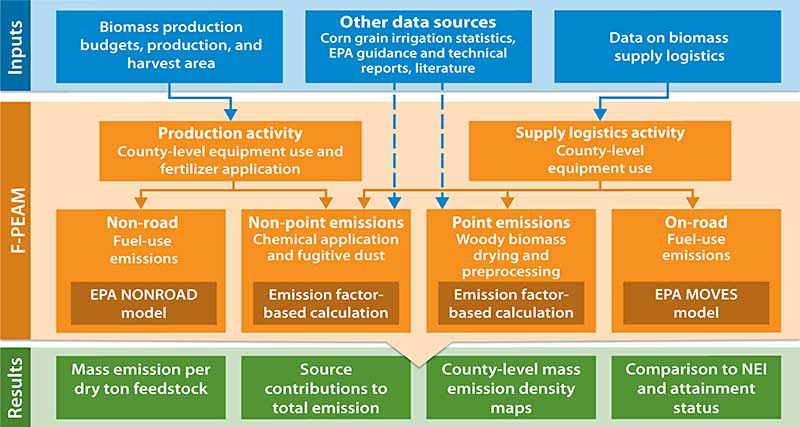Analyzing Air Pollutant Emissions From the Biofuel Supply Chain
NLR studies air pollutant emissions from the entire biofuel supply chain and their implications on air quality and human health.
Additionally, we study how air quality regulations can affect the cost, operation, and adaptability of the biofuels industry, generally, and biorefineries, specifically.

The Biofuel Supply Chain
The processes involved in growing biomass feedstocks and producing biofuels result in the emissions of a wide range of non-greenhouse gas air pollutants. Our work focuses on two important stages of the biofuel life cycle, namely (1) biomass production, harvest, and transport and (2) biomass conversion to biofuels in biorefineries.
Air pollutant emissions have local and regional impacts. At NLR, we develop and apply air pollutant emissions quantification tools and use county-level data to quantify air pollutant emissions for large-scale herbaceous and woody biomass production for biofuels. We also use the U.S. Environmental Protection Agency's (EPA's) guidance documents and models, a material balance approach, and permits for analogous units to develop emission estimates for biofuel conversion facilities.
Estimating Air Emissions From Biomass Feedstock Production, Harvest, and Transport
Feedstock Production Emission to Air Model
NLR has developed a rapid air emission estimation tool for feedstock production and harvest—the Feedstock Production Emission to Air Model (F-PEAM). F-PEAM is used to inventory the air pollutant emissions of large-scale biomass production, harvest, and transport processes that eventually deliver biomass to biofuel conversion facilities (biorefineries).

F-PEAM can flexibly take inputs from many disparate sources. Our most recent analysis incorporates data and assumptions used to develop feedstock production and supply logistics estimates in the U.S. Department of Energy's (DOE's) 2016 Billion-Ton Report: Advancing Domestic Resources for a Thriving Bioeconomy, Volume 1: Economic Availability of Feedstocks. For example, county-level feedstock production and "budgets" of equipment utilization and chemical input requirements were gathered from models developed by Oak Ridge National Laboratory, and the U.S. Department of Agriculture collected the corn irrigation data.
These inputs are used in a linked series of external models like the EPA's Motor Vehicle Emission Simulator (MOVES) to estimate county-level mass emissions of each air pollutant relevant to the formation of ozone and particulate matter (and other pollutants) in the atmosphere for each feedstock. To assess the potential significance of these modeled emissions, we compare the estimated emissions from the biomass supply chain to EPA's baseline National Emissions Inventory for similar source categories. We then map air emissions relative to areas not in compliance with EPA's National Ambient Air Quality Standards (NAAQS). This helps identify which counties have estimated future emissions from increased biomass production that could be of concern to air quality planners who must develop plans to achieve and maintain compliance with the NAAQS.
An NLR article, "Air Pollutant Emissions Inventory of Large-Scale Production of Selected Biofuels Feedstocks in 2022," documents the development of F-PEAM as well as the spatially explicit air pollutant emission inventory for one biofuel supply system that has the potential to produce sufficient feedstock to meet the Renewable Fuel Standard's biofuel volumetric requirements by 2022.
Billion Ton Studies
We analyzed the scenarios established in DOE's 2016 Billion-Ton Report: Advancing Domestic Resources for a Thriving Bioeconomy, Volume 1: Economic Availability of Feedstocks. Those results are published in Chapter 9—"Implications of Air Pollutant Emissions from Producing Agricultural and Forestry Feedstocks"—of DOE and Oak Ridge National Laboratory's analysis of potential environmental effects associated with biomass-production scenarios.
Estimating Air Emissions From Biorefineries
All industrial facilities that emit air pollutants must obtain permits for their emissions to begin construction and to operate. These permits are sometimes challenging to obtain for novel facilities like biorefineries that have different designs and processes as compared to commonplace facilities.
To help de-risk investment in new biorefineries, NLR:
- Evaluates air pollutant emissions and feasible controls to demonstrate that hypothetical biorefinery designs can achieve compliance with applicable federal air quality regulations
- Estimates the cost of achieving compliance and how achieving compliance could affect the cost to produce the biofuel (minimum fuel selling price)
- Investigates alternative pathways to achieve compliance.
To accelerate the process of permitting air emissions from biorefineries (for both applicants and regulators) we have collected available air permits for existing biorefineries in the United States and posted them to the U.S. DOE's Bioenergy Knowledge Data Framework.
Publications
Bio-Oil Co-Processing Can Substantially Contribute to Renewable Fuel Production Potential and Meet Air Quality Standards, Applied Energy (2020)
Potential Air Pollutant Emissions and Permitting Classifications for Two Biorefinery Process Designs in the United States, Environment Science and Technology (2017)
Federal Air Pollutant Emission Regulations and Preliminary Estimates of Potential-to-Emit from Biorefineries. Pathway #2: Conversion of Lignocellulosic Biomass to Hydrocarbon Fuels: Fast Pyrolysis and Hydrotreating Bio-Oil Pathway, NLR Technical Report (2017)
Economic Implications of Incorporating Emission Controls to Mitigate Air Pollutants Emitted from a Modeled Hydrocarbon-Fuel Biorefinery in the United States, Biofuels, Bioproducts, and Biorefining (2016)
Federal Air Pollutant Emission Regulations and Preliminary Estimates of Potential-to-Emit from Biorefineries, Pathway #1: Dilute Acid Enzymatic Deconstruction of Biomass to Sugars and Biological Conversion of Sugars to Hydrocarbons, NLR Technical Report (2016)
Air Pollutant Emissions Inventory of Large-Scale Production of Selected Biofuels Feedstocks in 2022, Biofuels, Bioproducts, and Biorefining (2015)
Process Design and Economics for the Conversion of Lignocellulosic Biomass to Hydrocarbon Fuels: Fast Pyrolysis and Hydrotreating Bio-Oil Pathway, NLR Technical Report (2013)
Process Design and Economics for the Conversion of Lignocellulosic Biomass to Hydrocarbons: Dilute-Acid and Enzymatic Deconstruction of Biomass to Sugars and Biological Conversion of Sugars to Hydrocarbons, NLR Technical Report (2013)
Contact
Share
Last Updated Dec. 7, 2025
